Cover letter structure - step-by-step guide to writing a cover letter
When it comes to writing a cover letter, you should know which elements should be included and in what order. The application is the first impression you make on your employer. And as you know, there is often no second chance to make a first impression. That's why it's important that your application letter is as professional and clear as possible.
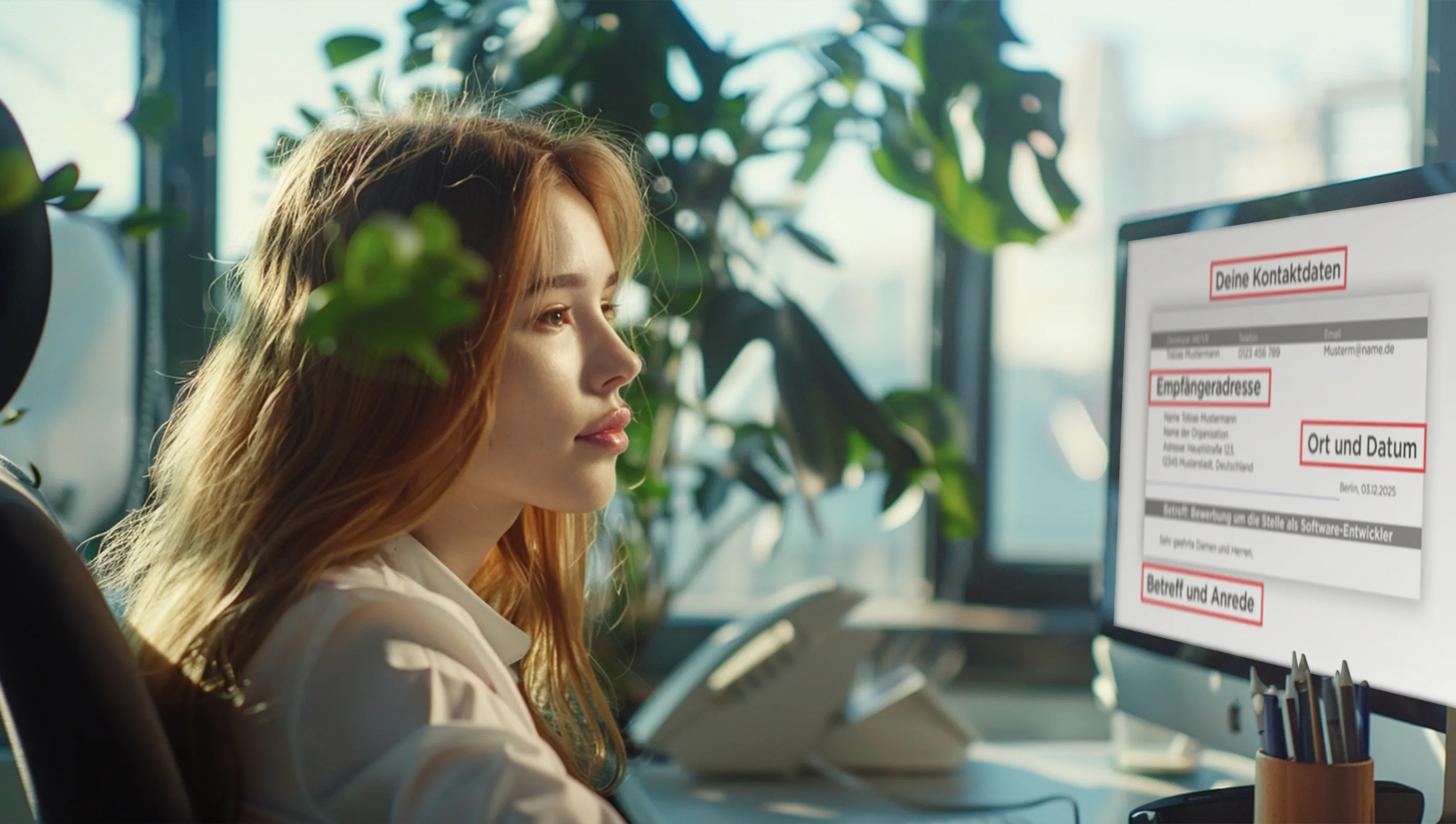
In this article, you will find a step-by-step guide to writing a cover letter that will help you stand out from other applicants. Remember that a clear structure and the right approach are a prerequisite for success in your job search.
Table of contents
Structure of the cover letter: the essentials
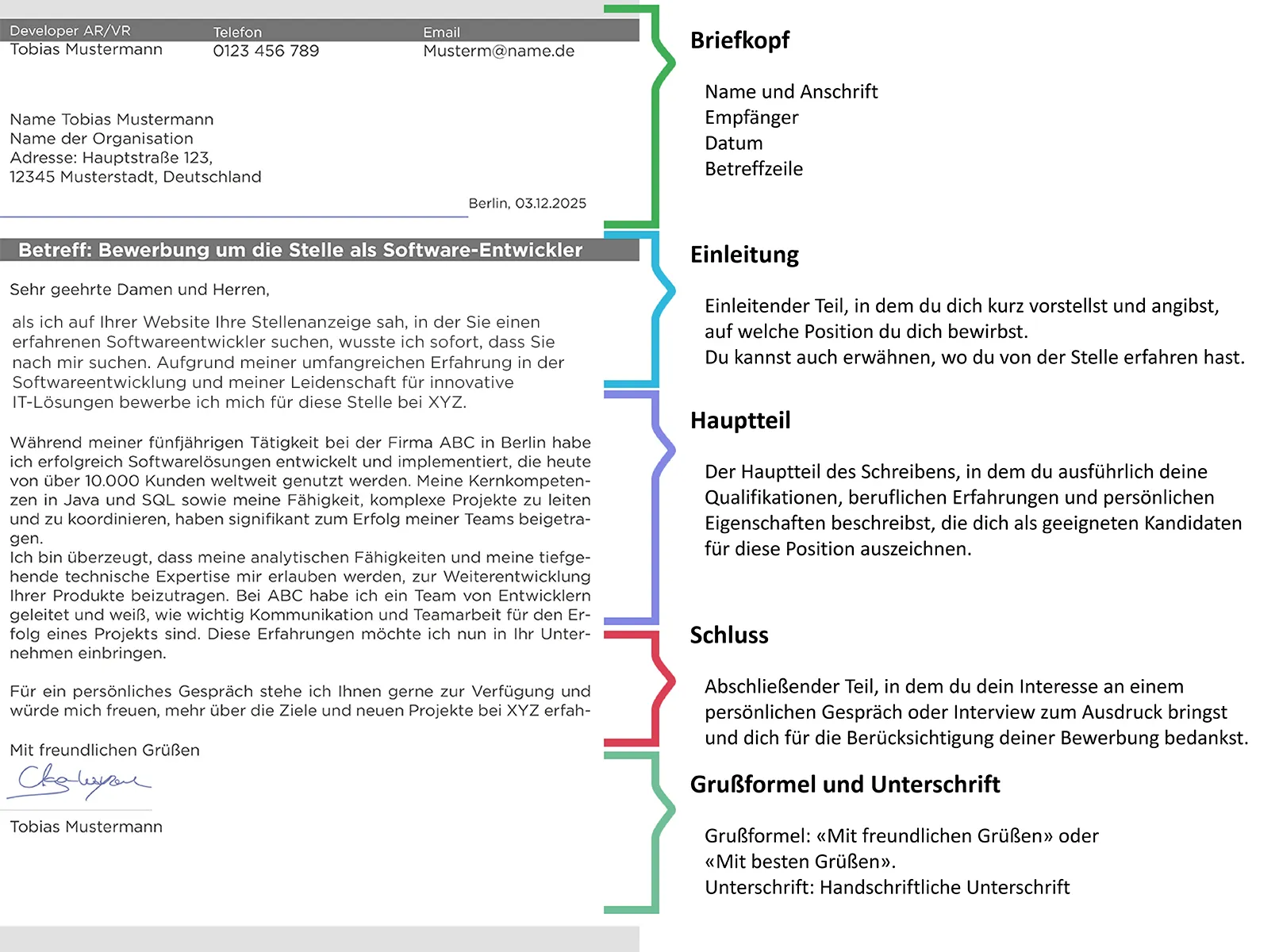
A cover letter is an important document in the job search because it often determines whether or not you are invited to an interview. It consists of several important parts, each of which has a specific function:
Sender and date: At the top left are your contact details (name, address, telephone number, e-mail) and the date on which you wrote the letter. Optionally, you can also add an application photo.
Recipient: This is followed by the contact details of the company to which you are sending your application (name of the company, contact person, address).
Subject: The subject provides brief and concise information about the reason for your letter, e.g. "Application for Marketing Manager".
Salutation: A personal salutation shows that you have engaged with the company. Ideally, you should address the contact person by name.
Introduction: In the introduction, you briefly and concisely explain why you are applying and what has aroused your interest in the position.
Main section: This is where you describe in detail your qualifications, experience and skills that make you suitable for the position. You should also explain why you are a good fit for the company and how you can offer added value.
Conclusion: In the closing section, you emphasize your motivation and thank the company for considering your application. You can also express your willingness and anticipation for an interview.
Greeting and signature: A friendly closing, followed by your handwritten signature, rounds off the application letter.
Letterhead
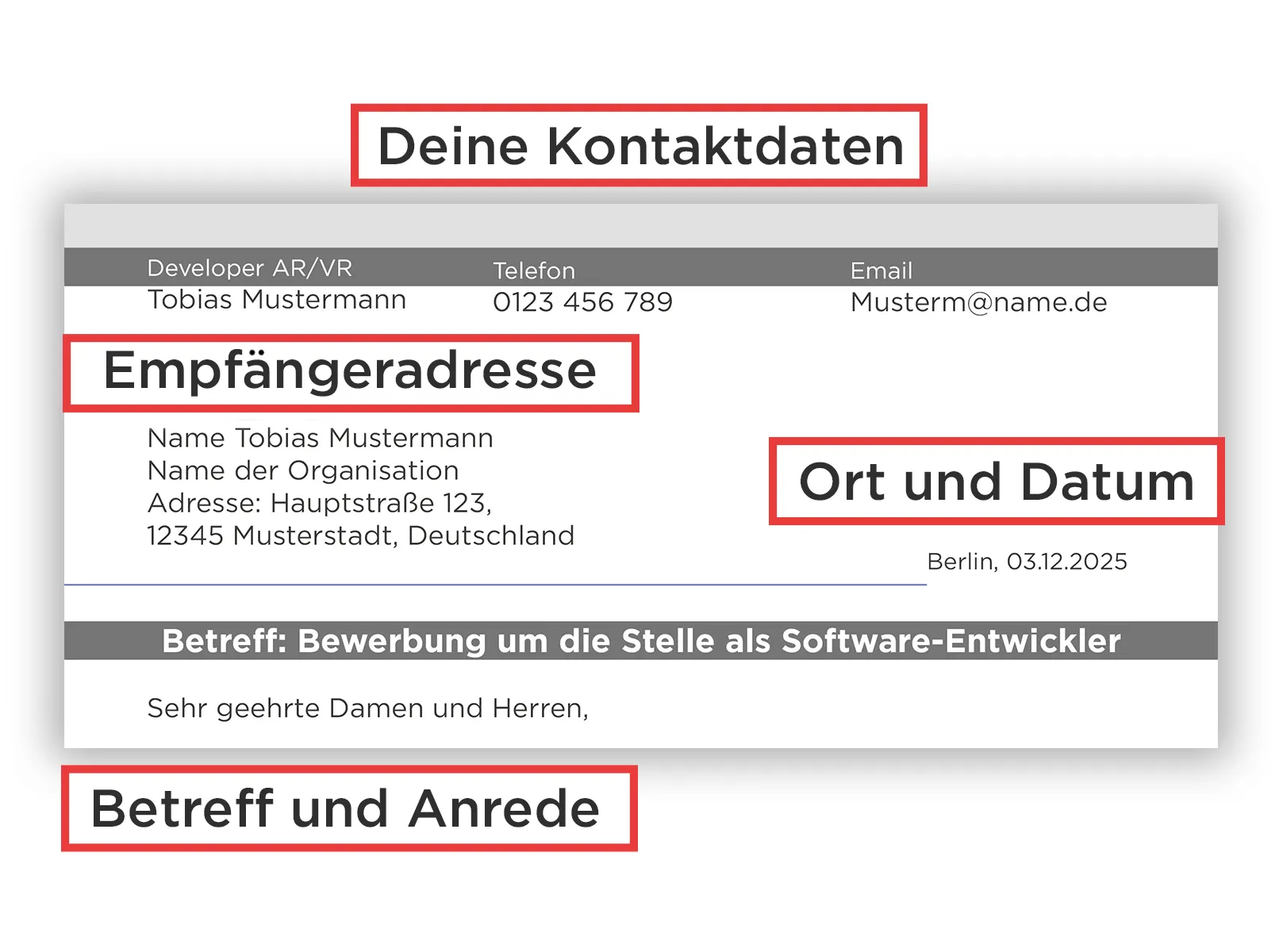
You should start with a header, which can be placed at the top or on the left-hand side of the document. It should include your contact information:
- First and last name;
- Address;
- phone number;
- e-mail address;
- optional links to business profile on LinkedIn or other industry networks.
The above information must be correct as the employer will use it to contact you if they want to invite you for an interview or provide you with additional information about the job and its requirements.
Introduction to the cover letter: this is how it should look
The introduction in your cover letter is the paragraph that gives the first impression of you as an applicant. The correct spelling of the introduction arouses interest in you as a person and thus determines whether the employer wants to take a closer look at your application and read your cover letter further. In Germany, for example, there are certain standards that should be observed.
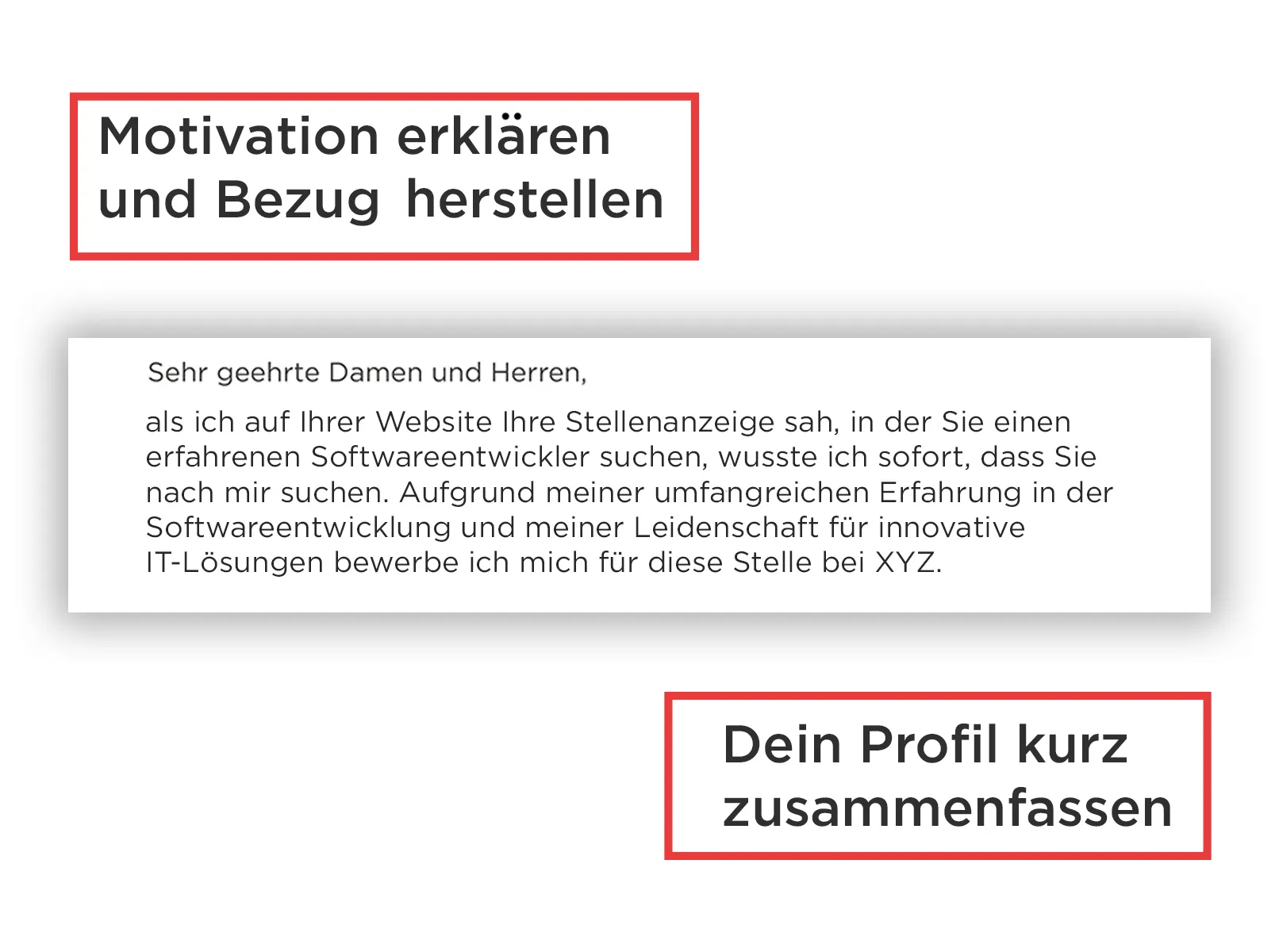
The right greeting in a cover letter
The salutation is the first thing the employer sees in your cover letter. It should therefore be formal, precise and personal. Here are the most important aspects of a good salutation:
Personalization: state the specific name of the contact person. If no name is given in the job advertisement, look it up on the company's website or call the HR department and ask who the correct addressee is for your application. This shows that you are paying attention and also proves that you can do better than those who only use anonymous salutations.
Formality: Use the formal form of address "Dear Madam" for women and "Dear Sir" for men and add the surname. This is the standard format in Germany. It is similar in other countries.
Correct form of address: If the person you are addressing has a title that indicates an academic degree, you should definitely use it (e.g. "Dr.", "Prof."). This shows your respect for the addressee. And to be honest, it also gives the holder of the title a little satisfaction to read their title in the salutation. On the other hand, it's a bit of a blow to the ego if the title holder's title is not mentioned.
An example of the correct greeting
- Dear Ms. Müller,
- Dear Mr. Schmidt,
- Dear Dr. Weber,
A personal greeting creates a positive first impression and shows that you have taken the time to prepare yourself. Using the correct salutation and formal address shows your respect for your future employer and their position. Formality and precision in your greeting also reflect your professionalism and attention to detail.
Remember that the right salutation sets the tone of the entire cover letter and can significantly increase your chances of a successful outcome.
🎯 Do you want your dream job? Take the first step towards success with our application templates . Download them now! 📄
What the introduction should contain and in what order
Start by mentioning the position you are applying for and where you heard about the vacancy. This will help the employer understand what type of job it is. Next, express your interest in the company and the position. Explain why you want to work here. Mention the key aspects of your qualifications that make you a suitable candidate. This should pique the employer's interest to continue reading your cover letter.
An example of a typical introduction, after the first sentence of which you will not get the job.
Dear Mr. Müller,
I read your job advertisement for the position of Marketing Manager on your company website with great interest. Due to my many years of experience in the field of marketing and my passion for creative communication strategies, I am convinced that I can make a valuable contribution to your team.
The phrase "with great interest" is a common cliché in cover letters. Don't use it, because you need to stand out from other applicants to get a good job. Such phrases come across as trite and do not convey any real added value about your qualifications or motivation. Instead, you should respond individually and specifically to the advertised position and the company.
Other examples of clichéd phrases that you should avoid:
"I hereby apply for the position of..."
Instead: Go straight to why you are the ideal candidate for the position and how your skills can benefit the company.
"I have extensive experience in..."
Instead: Show specific examples of your experience and achievements to emphasize your suitability.
"I am a team player and enjoy working in a team."
Instead: Describe a situation where your ability to work in a team made a difference and the results you achieved as a result.
"I am very motivated and look forward to new challenges."
Instead: Explain what excites you about the specific position and how you can translate your motivation into concrete results.
"I have studied your company intensively and find it very interesting."
Instead: Name specific projects, values or achievements of the company that appeal to you and explain how you can contribute to them.
By avoiding these clichés and using specific, meaningful phrases, you can make a lasting impression and significantly increase your chances of getting an interview.
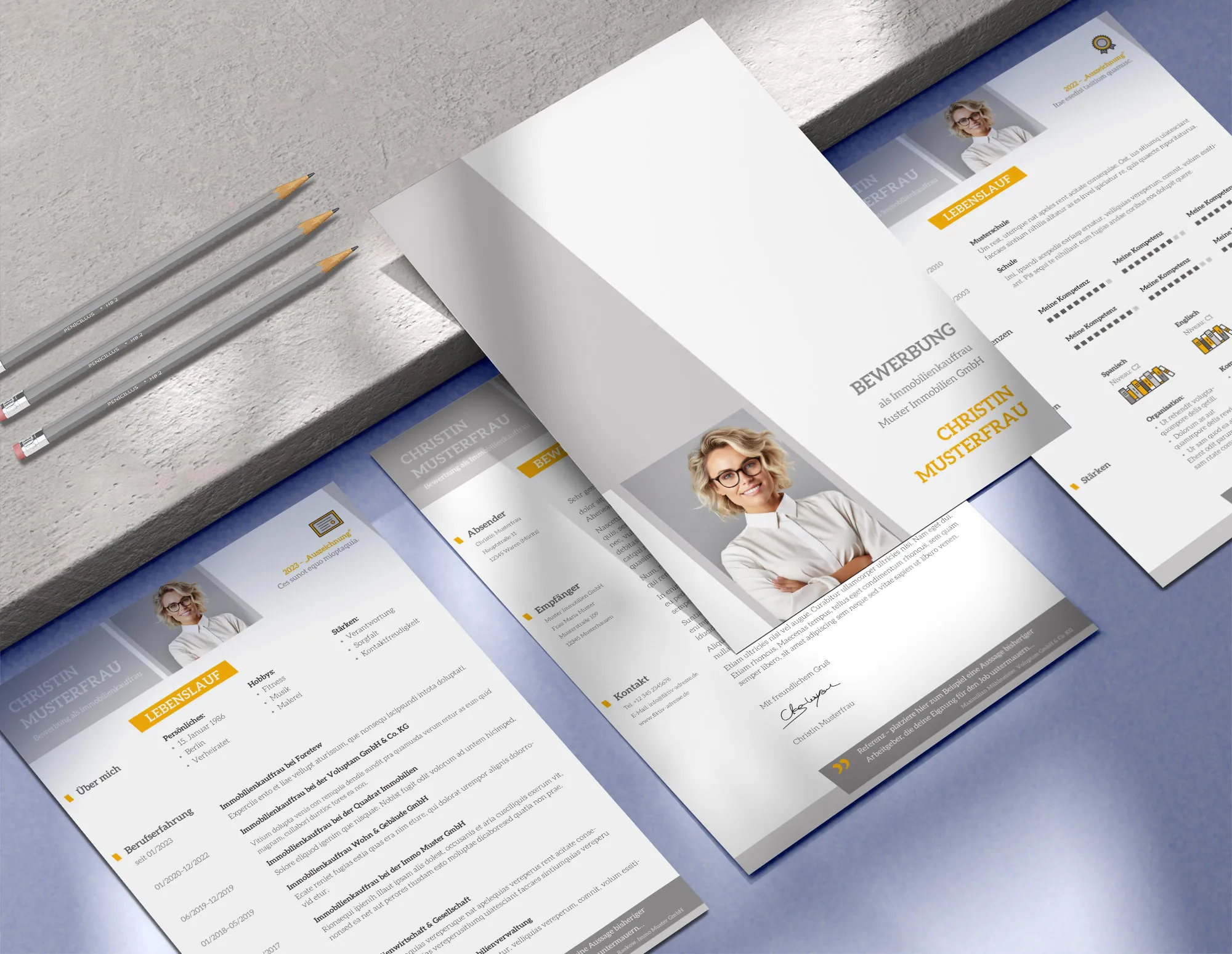
Why this structure is best for the introduction
The beginning of the letter should be as clear and specific as possible. This helps the employer to quickly understand what type of job it is and who the applicant is. By expressing your interest in the company and the position, you show that you are serious and prepared. A brief overview of your key qualifications will give the employer an idea of why you are the right candidate and encourage them to read your application further. By following these guidelines, you'll be able to write a strong introduction that grabs the employer's attention and makes a positive first impression.
The body of your cover letter
The main body is the heart of your cover letter. Here you should outline your qualifications, experience and motivation. The main body consists of several key elements, each with a clear purpose.
Describe why you want to work for this company and in this position. What attracts you to this company. Tell us about your professional experience that matches the requirements of the position. Highlight special achievements and projects.
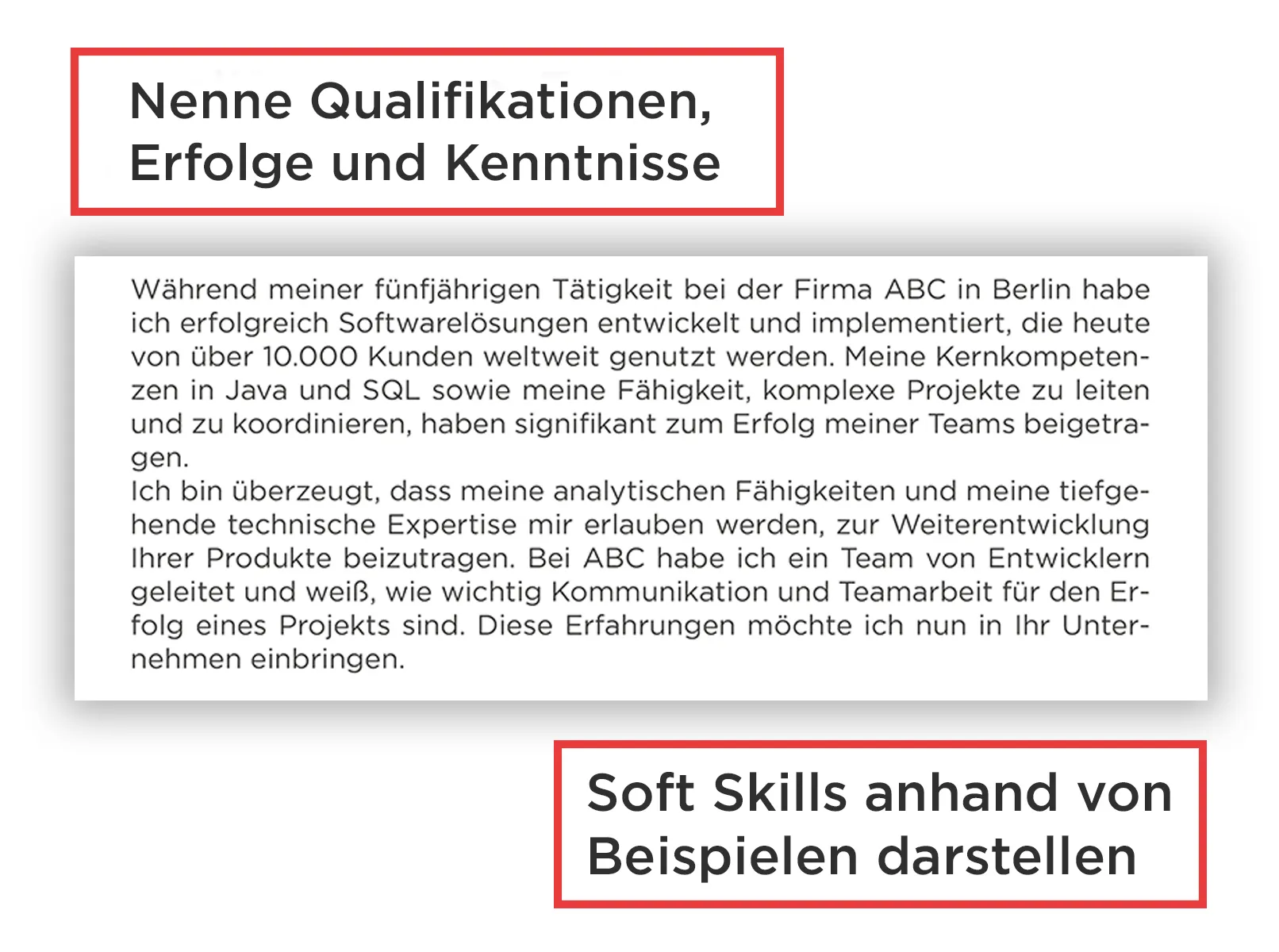
In this part of your cover letter, also list the key skills that make you the best candidate for the job. Emphasize how these skills will benefit the company. Describe your personal qualities that make you a unique candidate. For example, communication skills, ability to learn quickly, teamwork. Explain how you can contribute to the development of the company.
An example of the correct formulation of the main part
".... In my last position as Junior Sales Manager at Company X, I was responsible for acquiring new customers. In the first year, I managed to win 10 large customers and hone my skills in psychological dialog. This experience strengthened my ability to understand customers' needs and offer customized solutions.
In the second year, I also took over the management of existing clients and built long-term business partnerships through service-oriented and transparent communication. This led to a 35% increase in customer satisfaction.
My other strengths include excellent analytical skills and strategic thinking. During my internship at Company X, I analyzed the competition in the B2B marketing market and developed recommended actions that led to the successful acquisition of four new key accounts..."
The body of your cover letter should be well-structured and include all relevant information so that the employer understands why you are the best candidate for the job. Use specific examples and achievements to highlight your skills and experience.
💼 Ready for the next career leap? Our application templates will get you there. Download now and get started! 💪
Conclusion for the cover letter
The conclusion is the last part of the cover letter that leaves the final impression of you as an applicant. A well-written conclusion summarizes your motivation and makes the employer want to contact you for further interviews.
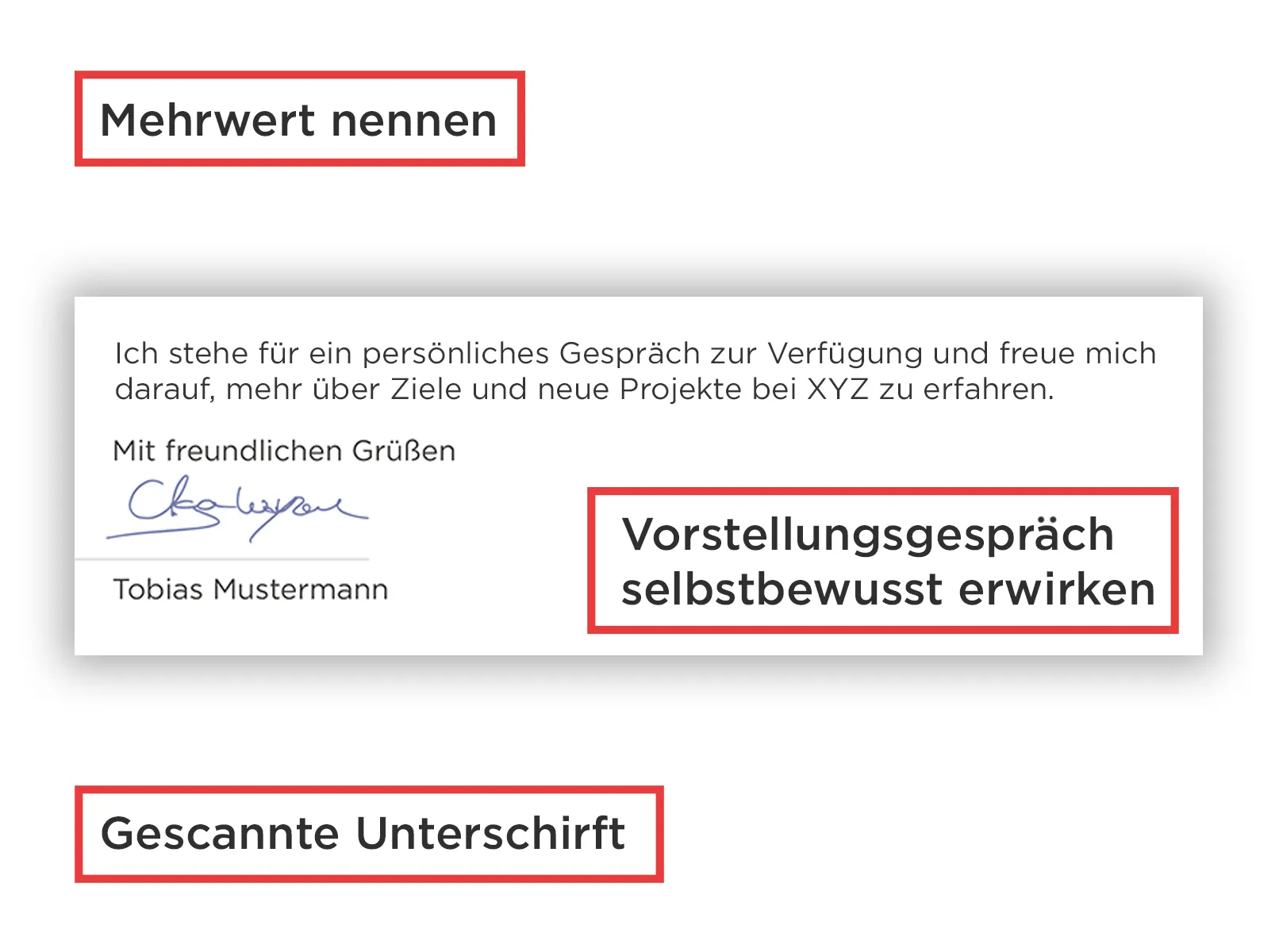
What the conclusion should contain
A call to action: Express your desire to meet for an interview or discuss the details over the phone. This shows your willingness to take further steps.
A thank you note: Thank the employer for considering your application. This shows your courtesy and respect.
It will motivate the employer to take concrete action, such as inviting you for an interview. It shows your respect and appreciation for their time. The polite wording of this part of the cover letter maintains a professional tone and ends the letter on a positive note. And of course, a signature makes the letter more personal and official.
📈 Set yourself up for success! Our application templates are the key to your dream job. Download them and start your career! 🔑
An example of a successful conclusion
"I am convinced that I can make a valuable contribution to the development of your company with my experience and skills.I look forward to discussingfurther details in a personal interview and explaining how I can strengthen your team."
The conclusion of your cover letter should be clear and concise. A call to action and an expression of gratitude create a positive impression and emphasize your willingness to take further steps. By following these guidelines, you can effectively complete your cover letter and increase your chances of being invited for an interview.
Greeting and signature in the cover letter
The greeting and signature are the last part of your cover letter. This completes the layout of the cover letter and creates a professional finish. This part should be clear and polite and follow certain standards.
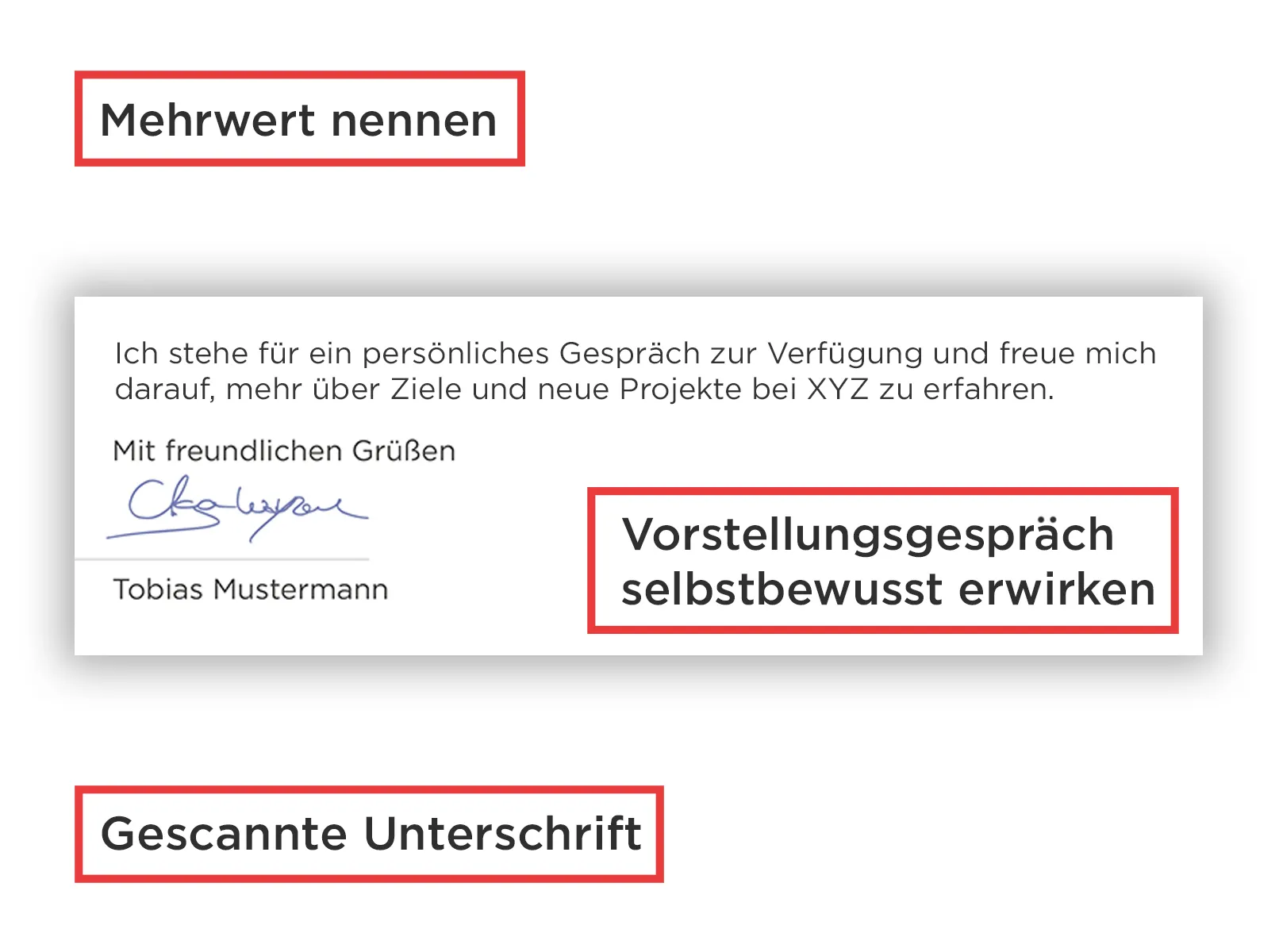
The structure of greetings and signatures in cover letters
Farewell
Use a polite standard farewell. The most common variant is "Yours sincerely,". It is suitable for all official correspondence. If you want to add a personal touch, you can also use less formal phrases, such as: "Yours sincerely".
Signature
Include your handwritten signature in the printed version and try to digitize it for the electronic version.
Date and place
It is an additional sign of professionalism to include the place and date below your signature. This small detail makes it clear how long you have been working on the job.
The polite closing formula is an established standard in German business correspondence and shows your respect and professionalism. A handwritten signature adds a personal touch and formality to the letter, which is important to make a positive impression.
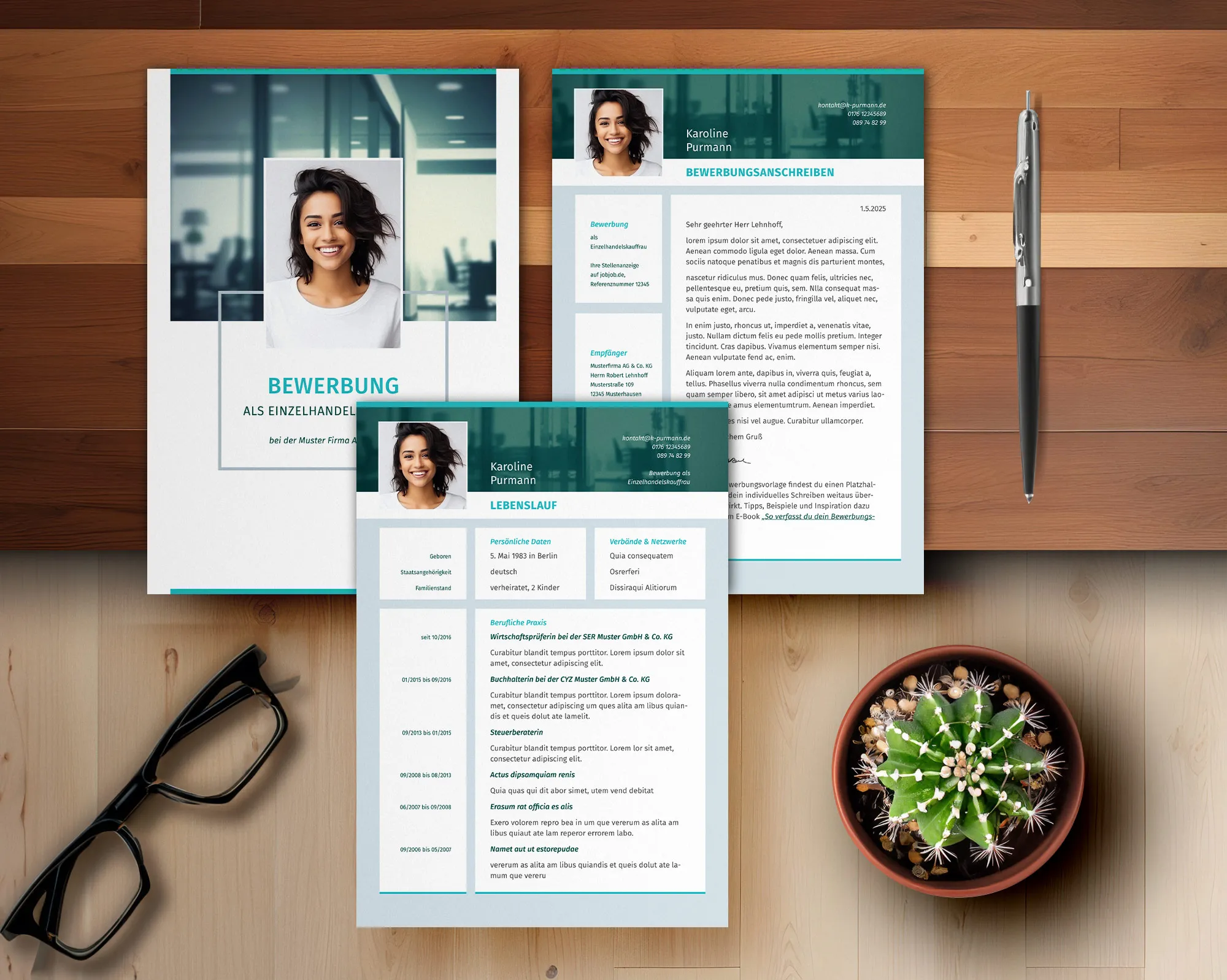
An example of a successful conclusion
Yours sincerely,
(Handwritten signature in a printed letter)
Alexander Mustermann
Waren, 16.05.2024
The correct formatting of the greeting and signature concludes your letter of application. A polite closing formula and a handwritten signature make a professional impression and show your attention to detail. Ideally, you should sign your letter with a blue fountain pen. With digital documents, the signature is scanned in neatly.
General requirements for a letter of application
The letter of application is an elementary document that accompanies your CV when you apply for a job. It should make a positive impression on the employer and highlight your professional and personal qualities. If you adhere to certain standards and requirements, the cover letter will be effective and professional.
- Size: The cover letter should be short and concise, usually no more than one A4 page. The optimal length is 3-4 paragraphs that clearly describe your motivation, qualifications and experience. Follow a clear structure that includes a title, salutation, body and conclusion.
- Include a photo: In Germany, for example, it is customary to include a photo with your cover letter. It should be professional and of high quality and match the style of the company. It is best to place the photo in the top left-hand corner.
- Font requirements: Use standard business fonts such as Arial, Times New Roman or Calibri. The font should be easy to read and professional. The optimum size is 11-12 points. This makes it easy to read and does not overload the page with text. Use single line spacing and left alignment. Separate paragraphs with a blank line to increase clarity.
- Formatting: Set the margins to standard (2.5 cm on each page). This gives you enough space for printing and reading. Start each paragraph indented or separate paragraphs with a blank line to structure the text better.
- Language and style: Use clear and professional language. Avoid jargon, slang and overly complex sentences. Maintain a formal and polite tone. This shows your respect for the employer and your seriousness.
- Content: It is important that all the information in your cover letter is relevant to the job you are applying for. Use specific examples to illustrate your qualifications and experience.
Creating a high-quality cover letter is not an easy task that requires a lot of time and attention. You need to gather all the necessary information, structure it and make it relevant to the requirements of the job. Ready-made application templates created by professional designers and structured according to job requirements can help you with this. Their design will definitely catch the attention of most employers. All you have to do is fill them in with your information.

Post Scriptum
More helpful articles from us about the application process:
- Follow the link to see a real-life example of 10 typical mistakes when writing a job application. I promise you won't regret it.
- And here you can prepare for the questions you will be asked in the interview (interview questions).
- And, of course, read how important it is to take a professional photo for your application.
- How to take a professional photo for your application yourself at home.
From Vitalii Shynakov
